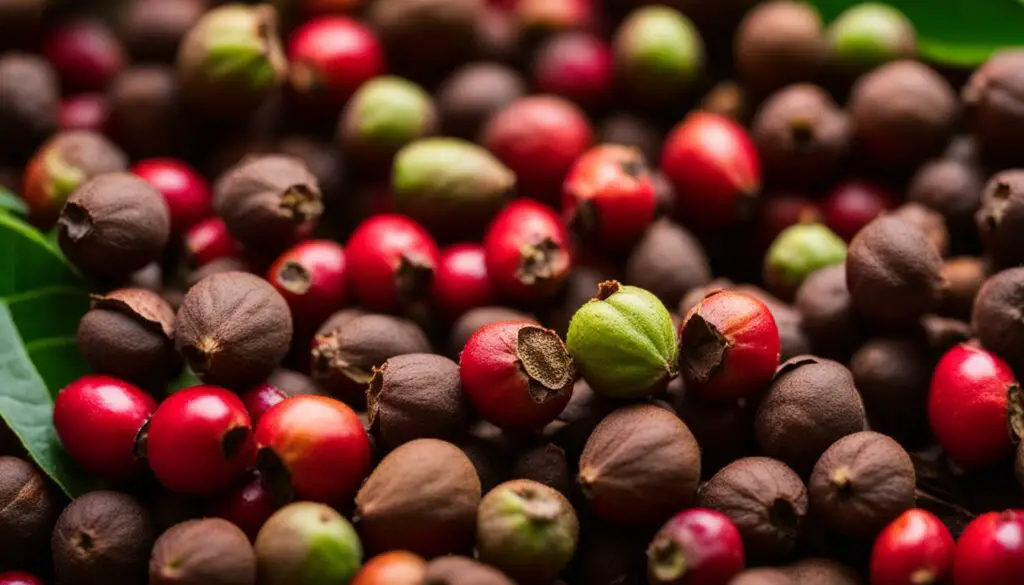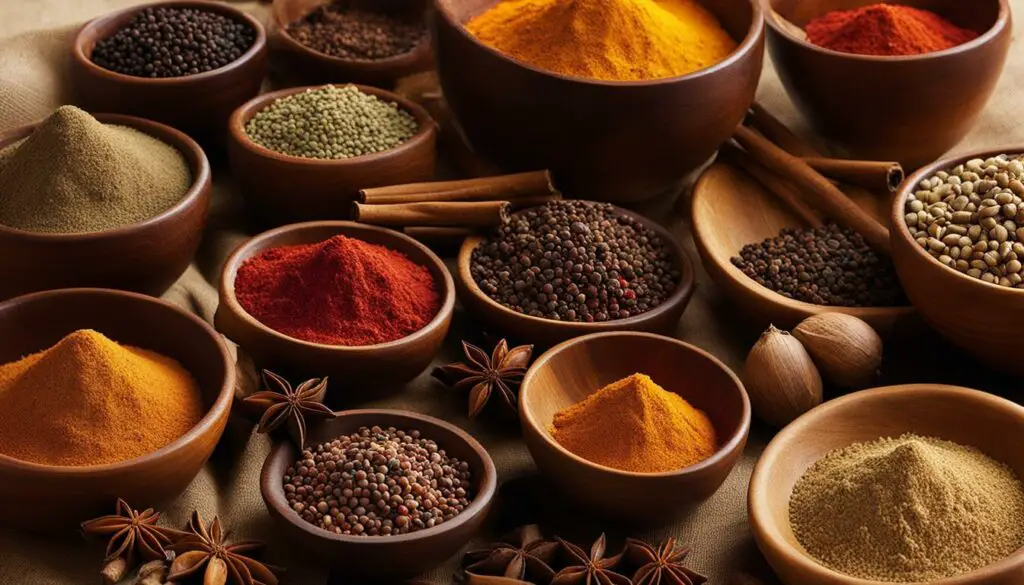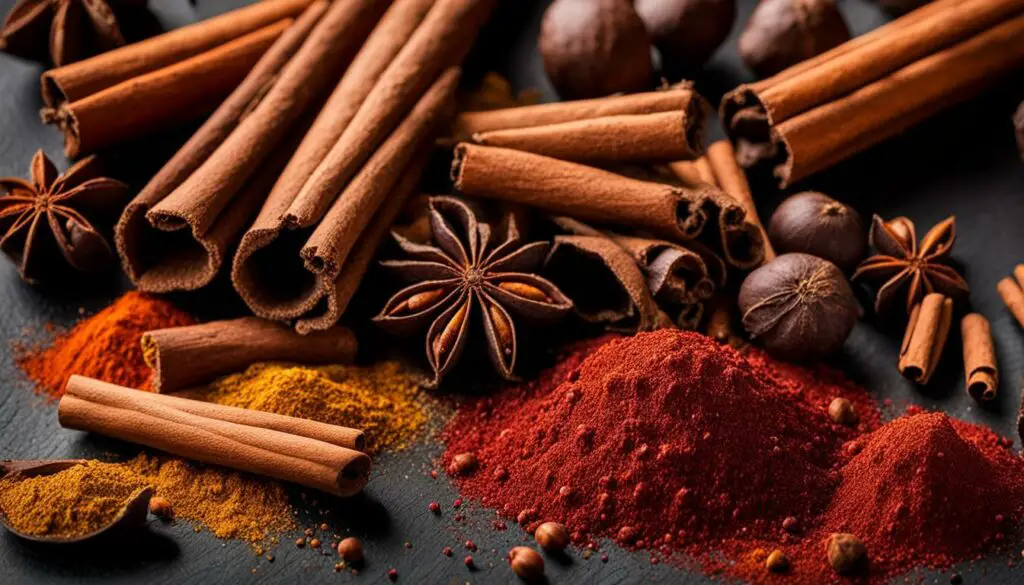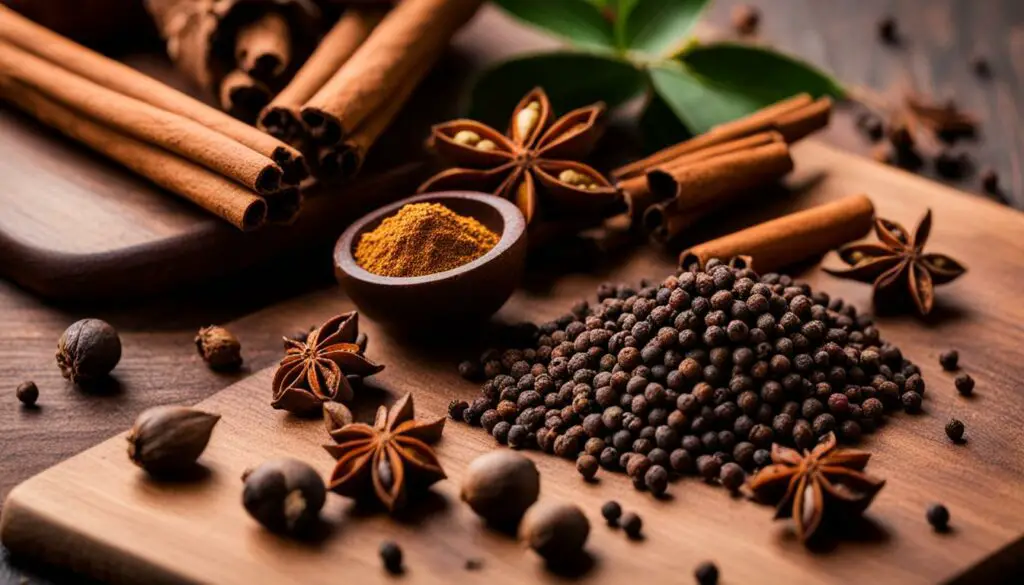Originally posted on December 4, 2023 @ 4:24 am
Allspice is a versatile spice that adds aromatic warmth to both sweet and savory dishes. However, if you find yourself without allspice or need a substitute, there are several options available. Let’s explore some creative ways to replace allspice in your favorite recipes.
Whether you’re out of allspice or simply want to try something different, these substitutes will help you achieve similar flavors in your dishes. Here are some key takeaways:
Table of Contents
Key Takeaways:
- Ground cloves provide a similar dark color and a combination of sweetness and pungency to replace allspice in recipes.
- Nutmeg has a similar flavor profile to allspice and can be used in a one-to-two ratio.
- Cinnamon can be used as a substitute for allspice, especially in a pinch.
- Ready-made spice blends like pumpkin pie spice and Chinese five-spice powder can also be used as substitutes for allspice.
- Experiment with different spice blends or create your own unique blend for exciting flavor combinations.
Understanding Allspice and its Origins

Allspice is made from the dried berries of the Pimenta dioica tree, which is native to the Caribbean and Central America. It has a flavor profile that is reminiscent of cinnamon, nutmeg, and cloves, with a hint of bite like black pepper. Allspice is commonly used in Latin American, Caribbean, Middle Eastern, and Indian cuisines. It is an essential component in dishes like Jamaican jerk seasoning, chai tea, and Christmas pudding. Ground allspice is more commonly used in recipes, but whole berries are also used in certain dishes.
The Flavor of Allspice
Allspice is known for its unique flavor that combines various aromatic notes. It offers a warm and slightly sweet taste, with hints of cinnamon, cloves, and nutmeg. The flavor is versatile, making it a popular choice in both sweet and savory dishes. Its distinctive profile adds depth and complexity, enhancing the overall taste of a wide range of recipes.
| Allspice Flavor Profile | Notes |
|---|---|
| Aroma | Cinnamon, cloves, nutmeg |
| Taste | Warm, slightly sweet |
| Usage | Latin American, Caribbean, Middle Eastern, and Indian cuisines |
“The unique flavor of allspice adds a special touch to my grandmother’s Christmas pudding recipe. The combination of cinnamon, cloves, and nutmeg creates a warm and nostalgic aroma that fills the house during the holidays.”
Allspice seasoning is a versatile ingredient that can elevate the taste of various dishes. Understanding its origins and flavor profile can help you appreciate its role in different cuisines and inspire you to experiment with alternative spices when needed.
Allspice Alternatives: Ground Cloves
If you find yourself without allspice or simply need a substitute, ground cloves can be a fantastic alternative. They provide a similar dark color and a combination of sweetness and pungency that is reminiscent of allspice. You can use ground cloves in a one-to-one ratio to replace ground allspice in your recipes. However, it’s important to note that cloves have a stronger flavor than allspice, so it’s recommended to add them gradually to avoid overpowering the dish. To recreate the peppery notes of allspice, you can also add a bit of black pepper.
Table: A Comparison of Allspice and Ground Cloves
| Allspice | Ground Cloves |
|---|---|
| Aromatic warmth | Similar aromatic warmth |
| Flavors of cinnamon, nutmeg, and cloves | Strong flavor of cloves |
| Used in Latin American, Caribbean, Middle Eastern, and Indian cuisines | Can be used in various cuisines |
| Commonly used in Jamaican jerk seasoning, chai tea, and Christmas pudding | Does not have specific traditional uses |
When using ground cloves as an allspice substitute, it’s important to keep in mind that their flavor can be intense. Start with the recommended ratio and adjust to taste. The goal is to achieve a similar flavor profile without overpowering the other ingredients in your dish. By gradually adding ground cloves and tasting as you go, you can ensure a balanced and delicious result.
Ground cloves are readily available in most grocery stores and can be a convenient and accessible substitute for allspice. However, if you prefer a different flavor profile, there are other alternatives to explore, such as nutmeg and cinnamon. Feel free to experiment with different combinations and ratios to find the perfect substitute for your favorite recipes.
Allspice Alternatives: Nutmeg

If you’re looking for a versatile substitute for allspice, nutmeg is a fantastic option. It shares a similar flavor profile and adds a touch of warmth to your dishes. Its slightly nuttier and simpler taste complements both sweet and savory recipes. To replace allspice with nutmeg, start with a one-to-two ratio and adjust according to your preference. For an extra kick, you can add a dash of black pepper along with nutmeg to recreate the peppery notes of allspice.
Nutmeg can be used in a variety of recipes, including baked goods like pies, cookies, and cakes. It pairs well with fruits, root vegetables, and creamy sauces. Its versatility makes it a popular choice in both traditional and modern cooking. Just remember to grate fresh nutmeg for the best flavor, as pre-ground nutmeg can lose its potency over time.
Table: Nutmeg as an Allspice Substitute
| Ingredient | Quantity Equivalent to 1 tsp of Allspice |
|---|---|
| Nutmeg (ground) | 1/2 tsp |
| Nutmeg (freshly grated) | 1/4 tsp |
Experiment with nutmeg in your favorite recipes to discover new flavor combinations and add a hint of warmth and complexity. Whether you’re making a comforting winter stew or a batch of spiced cookies, nutmeg can elevate your dishes to the next level.
Allspice Alternatives: Cinnamon
Cinnamon can be used as a substitute for allspice, especially in a pinch. It has a milder and sweeter flavor compared to allspice but still adds a pleasant earthiness to dishes. Cinnamon can be used in a one-to-one ratio to replace ground allspice in recipes. To add a touch of peppery flavor, a bit of black pepper can be sprinkled in as well.
Table: Allspice Alternatives Comparison
| Spice | Flavor | Substitution Ratio |
|---|---|---|
| Cinnamon | Milder, sweeter, earthy | 1:1 |
| Ground Cloves | Strong, pungent, sweet | 1:1 |
| Nutmeg | Nuttier, simpler | 1:2 |
When using cinnamon as a substitute for allspice, keep in mind that it may not provide the exact same flavor profile, but it can still enhance the taste of your dishes. It works well in both sweet and savory recipes, so feel free to explore and experiment with different combinations.
Allspice Alternatives: Other Spice Blends and Substitutes

Aside from individual spices, there are also ready-made spice blends available that can serve as excellent substitutes for allspice. Two popular options include pumpkin pie spice and Chinese five-spice powder.
Pumpkin pie spice is a blend of ground cinnamon, nutmeg, ginger, and cloves. It shares similar warm and aromatic notes with allspice, making it a great alternative. When using pumpkin pie spice as a substitute, you can use it in a one-to-one ratio to replace ground allspice in recipes.
Chinese five-spice powder is a blend of star anise, cloves, Chinese cinnamon, Sichuan peppercorns, and fennel seeds. While it has its own unique flavor profile, Chinese five-spice powder can add depth and complexity to dishes that would typically call for allspice. Use it in a one-to-one ratio as a replacement for ground allspice in recipes.
Experimenting with different spice blends or creating your own unique blend can add an exciting twist to your dishes. Each blend brings its own distinctive flavors and can offer a fresh and unexpected perspective on familiar recipes.
| Spice Blend | Ingredients | Flavor Profile |
|---|---|---|
| Pumpkin Pie Spice | Ground cinnamon, nutmeg, ginger, cloves | Warm, aromatic |
| Chinese Five-Spice Powder | Star anise, cloves, Chinese cinnamon, Sichuan peppercorns, fennel seeds | Complex, bold |
When substituting allspice with spice blends, refer to the specific recipe and adjust the quantities as needed. Taste as you go to ensure the flavors are balanced and to your liking. Incorporating alternative spice blends can open up a world of possibilities in your culinary endeavors.
Tips for Using Allspice Substitutes

When it comes to using allspice substitutes, there are a few key tips to keep in mind. Whether you’re experimenting with different flavors or simply don’t have allspice on hand, these tips will help you achieve delicious results in your recipes.
Adjust Amounts and Ratios
When using allspice substitutes, it’s important to adjust the amounts and ratios of spices based on your personal preference and the desired flavor profile. Start with the recommended ratios and gradually increase or decrease the amount to suit your taste. Remember that each substitute may have its own unique flavor, so tasting as you go and making adjustments is key.
Consider Flavor Profiles
While allspice substitutes can provide similar flavors, they may have slight differences in taste. For example, cloves have a stronger flavor than allspice, while nutmeg has a nuttier and simpler taste. Take these flavor profiles into account when choosing a substitute and adjust accordingly to achieve the desired outcome.
Experiment with Blends
In addition to individual spices, spice blends can also be used as substitutes for allspice. Popular blends like pumpkin pie spice and Chinese five-spice powder contain a combination of spices that provide a similar flavor profile. Don’t be afraid to experiment with different blends or even create your own unique spice blend to add a twist to your dishes.
Using allspice substitutes opens up a world of possibilities in your cooking. Whether you’re trying to replace allspice or simply want to explore different flavors, these tips will help you navigate the world of spice substitutions. With a little creativity and taste-testing, you can achieve flavorful and satisfying results in your favorite recipes.
Exploring the Versatility of Allspice in Cooking

Allspice is a truly versatile spice that adds a unique flavor profile to a wide range of dishes. Its warm and aromatic notes make it a favorite among chefs and home cooks alike. Here are some exciting ways to incorporate allspice into your cooking:
- Baking: Allspice is a key ingredient in many holiday treats like gingerbread cookies and pumpkin pie. Its combination of cinnamon, nutmeg, and clove flavors adds a delightful warmth to baked goods.
- Savory dishes: Allspice is a crucial component in savory recipes, particularly in Middle Eastern and Caribbean cuisines. It pairs well with meats like beef, pork, and lamb, adding depth and complexity to stews, soups, and marinades.
- Spice blends: Allspice is often used in spice blends like Jamaican jerk seasoning, where it provides a distinctive kick. You can also create your own unique spice blend by combining allspice with other complementary spices like cinnamon, cloves, and black pepper.
- Beverages: Allspice can be used to infuse warm drinks like mulled wine, cider, and chai tea with its rich and comforting flavors. It adds a touch of warmth and sophistication to your favorite beverages.
“Allspice brings a unique flavor to both sweet and savory dishes, making it a versatile addition to any pantry.”
To truly explore the versatility of allspice, try experimenting with different recipes and cuisines. Don’t be afraid to get creative and add a pinch of allspice to unexpected dishes – you might be pleasantly surprised by the complex and delicious results.
Table: Allspice in Different Cuisines
| Cuisine | Popular Dishes |
|---|---|
| Caribbean | Jamaican jerk seasoning, Caribbean stews |
| Middle Eastern | Shawarma, baharat spice blend |
| Indian | Chai tea, biryani |
As you can see from the table, allspice is widely used in Caribbean, Middle Eastern, and Indian cuisines. Its distinct flavor adds a unique touch to these traditional dishes, elevating the overall taste experience.
So, the next time you’re in the kitchen, don’t forget to reach for the allspice. Its versatility and rich flavor will undoubtedly enhance your culinary creations.
How to Store Allspice and Allspice Substitutes
Allspice berries and ground allspice should be stored properly to maintain their freshness and flavor. Here are some tips on how to store allspice and allspice substitutes:
Storing Allspice:
Allspice berries can last up to 3 to 4 years when stored in an airtight container. It’s important to keep them away from heat and light, as exposure to these elements can cause the spice to lose its flavor and potency. Ground allspice, on the other hand, has a shorter shelf life and can last up to 1 year under the same storage conditions. It’s recommended to label the container with the date of purchase to keep track of its freshness.
Storing Allspice Substitutes:
If you’re using allspice substitutes like ground cloves, nutmeg, or cinnamon, it’s important to store them properly as well. Like allspice, these substitutes should be kept in airtight containers in a cool, dark space to maintain their freshness and flavor. Make sure to label the containers to avoid confusion and ensure easy access when needed.
Proper storage of allspice and its substitutes not only helps them last longer but also ensures that they retain their aroma and taste. By following these storage tips, you can continue to enjoy the flavors of allspice and its substitutes in your favorite recipes.
Note: The image above depicts the proper storage of allspice and its substitutes.
Conclusion
In conclusion, when you find yourself without allspice or in need of a substitute, there are several creative alternatives to choose from. Ground cloves, nutmeg, and cinnamon can all be used as replacements for allspice, each offering their own unique flavors. Additionally, ready-made spice blends like pumpkin pie spice and Chinese five-spice powder can be used to recreate the flavor profile of allspice.
When using these substitutes, it’s important to adjust the amounts and ratios based on personal preference and the desired taste. Start with the recommended ratios and make adjustments as needed, keeping in mind that each substitute may have its own distinct flavors. Tasting as you go will help you achieve the perfect balance in your dishes.
While allspice is a versatile spice that adds warmth and depth to both sweet and savory recipes, don’t be afraid to experiment with substitutes. With a little creativity, you can still create delicious dishes that are just as flavorful, even without allspice. So next time you run out or need a replacement, reach for one of these alternatives and let your culinary skills shine!
FAQ
Can I substitute ground cloves for allspice?
Yes, ground cloves can be used as a substitute for allspice. Use them in a one-to-one ratio to replace ground allspice in recipes. Just be careful not to overpower the dish with the stronger flavor of cloves.
What can I use instead of allspice?
If you don’t have allspice, you can try substituting with nutmeg or cinnamon. Both have similar flavor profiles and can be used in a one-to-one ratio to replace ground allspice in recipes.
Are there any ready-made spice blends that can replace allspice?
Yes, pumpkin pie spice and Chinese five-spice powder are both spice blends that can provide a similar flavor profile to allspice. You can use them in a one-to-one ratio to replace ground allspice in recipes.
How should I adjust the amounts of substitutes when using them instead of allspice?
It’s best to start with the recommended ratios and gradually increase or decrease the amount to suit your taste. Remember that the substitutes may have their own unique flavors, so taste as you go and make adjustments accordingly.
What dishes can I use allspice substitutes in?
Allspice substitutes can be used in a variety of dishes, both sweet and savory. They are commonly used in holiday desserts like gingerbread and pumpkin pie, as well as in stews, soups, marinades, and jerk seasoning.
How long does allspice last?
Allspice berries will last up to 3 to 4 years when stored in an airtight container away from heat and light. Ground allspice will last up to 1 year under the same conditions.
How should I store allspice substitutes?
Allspice substitutes should be stored in airtight containers in a cool, dark space to maintain their freshness and flavor. Labeling the containers will help to avoid confusion and ensure easy access when needed.
Source Links
- https://insanelygoodrecipes.com/allspice-substitute/
- https://www.verywellfit.com/the-best-substitutes-for-allspice-5208080
- https://www.simplysouthernmom.com/how-to-make-allspice-substitute/
See also:
Leave a Reply